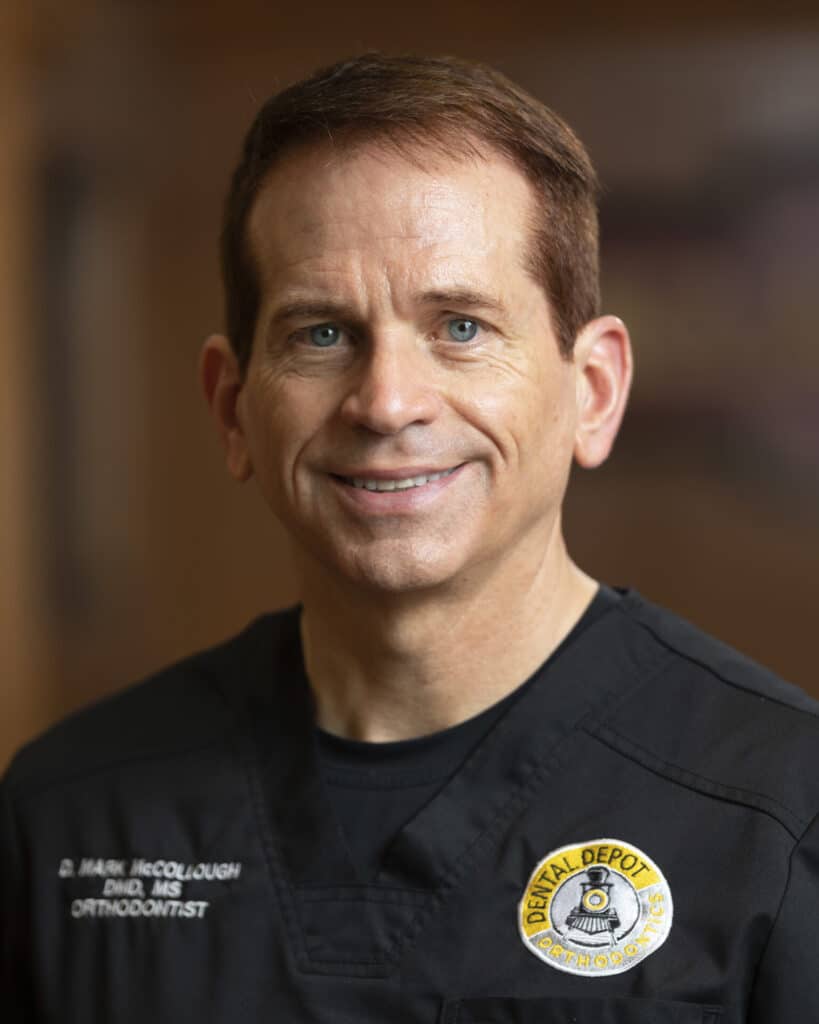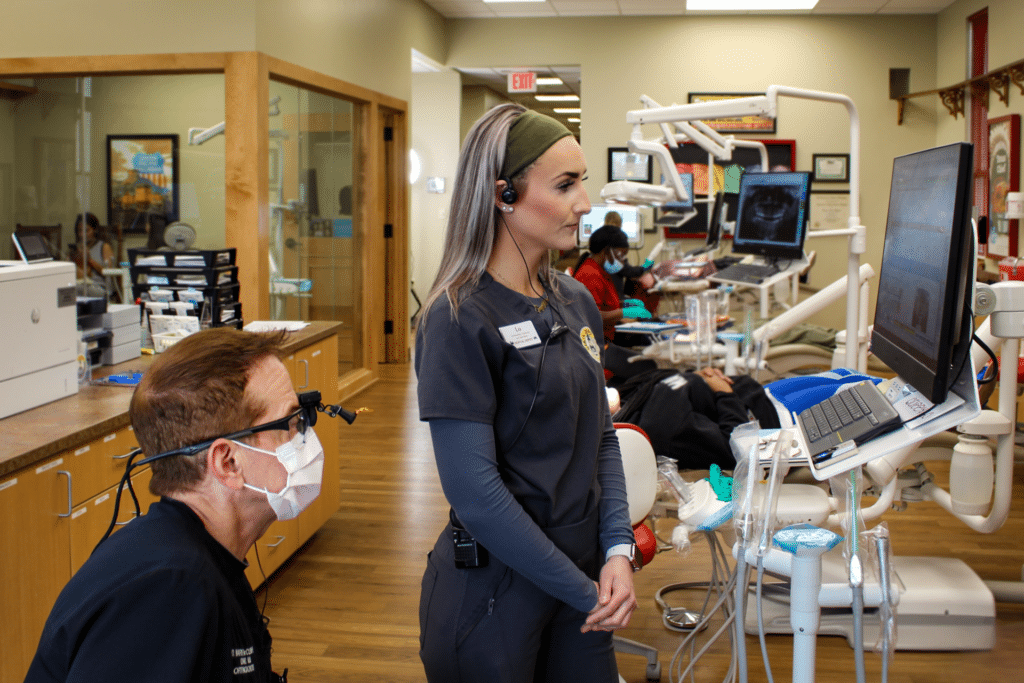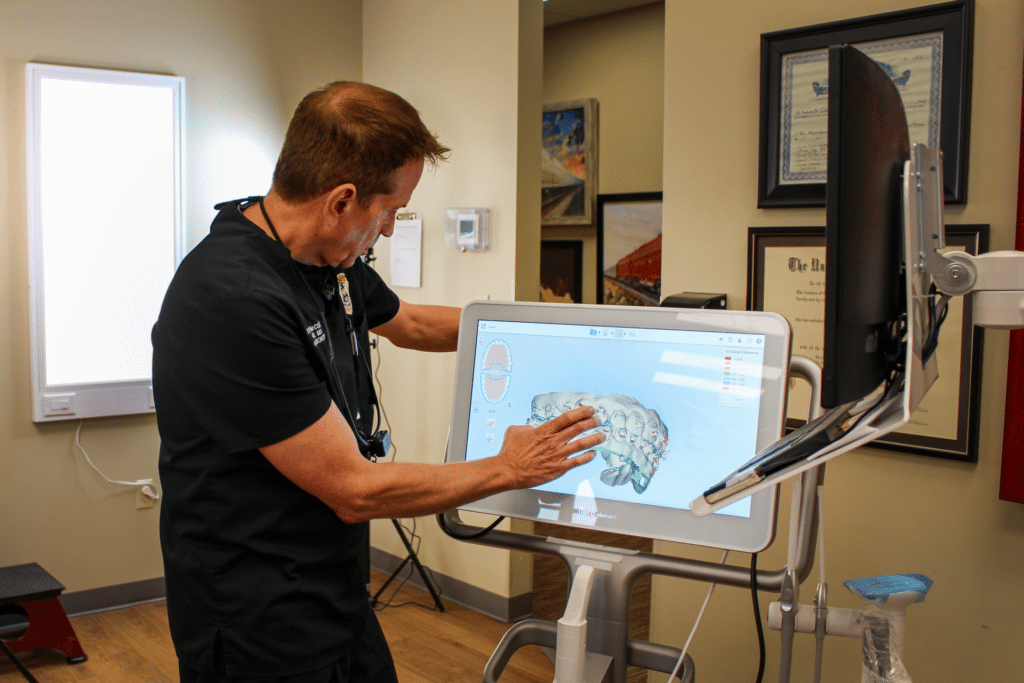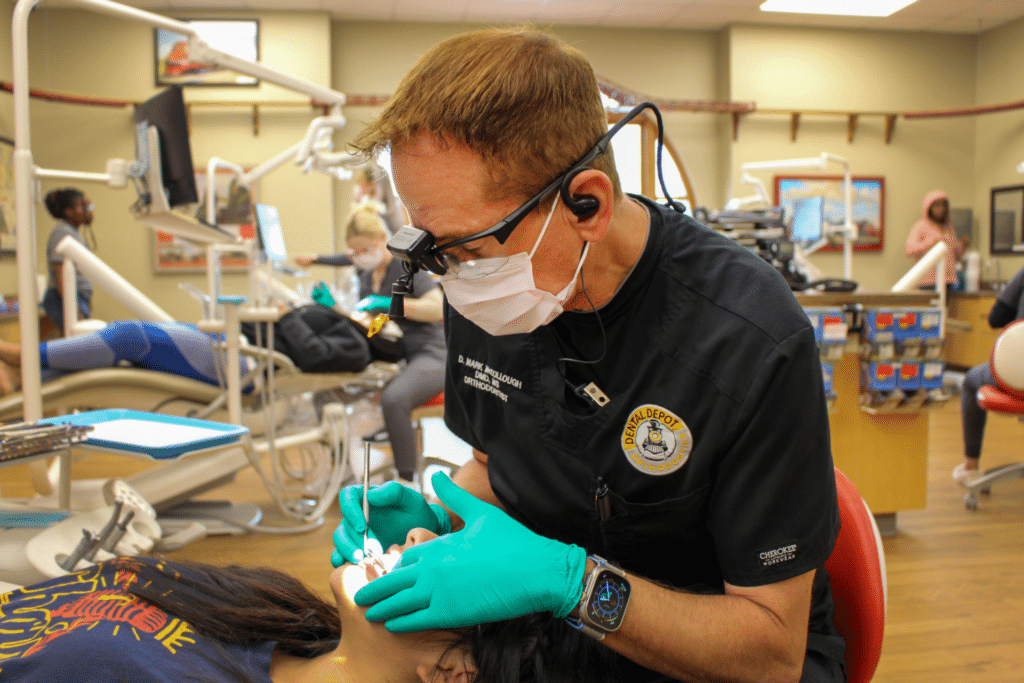An Exclusive Interview with Dr. Mark McCollough, Orthodontist at Dental Depot Northwest Expressway.
Can Invisalign help you? We spoke with an orthodontist at one of our local orthodontics centers in Oklahoma City, to discover insight into how the process of Invisalign treatment works and who can benefit from it. With decades of experience in general dentistry and orthodontics, Dr. Mark McCollough is passionate as ever about bringing a smile to his patient’s faces.

Dental Depot
Thank you for chatting with us today, Dr. McCollough.
Dr. Mark McCollough
My pleasure, and you can call me Dr. Mark. My patients just call me Dr. Mark.
DD
Absolutely! Well, can you tell us a little bit about yourself?
MM
I have a wonderful family and a wonderful wife of 41 years. We got three kids and four grandkids now. My middle daughter just had a baby, and my youngest one is going to OSU.
I’m a big fan of Jeeps, and I love to run and do triathlons.
Other than that, professionally, I’m an orthodontist here at Dental Depot Orthodontics on Northwest Expressway.
DD
How long have you been practicing orthodontics? How’d you get into the field?
MM
I’ve done it for quite a while. Altogether about 37 years. So, I began as a general dentist for the first eight years of my career. I also was in the military for 28 years, part of that was as a general dentist, and the other part was as an orthodontist. I’ve been working with Dental Depot for the past seven years.

I’m a member of the American Association of Orthodontists and a board-certified orthodontist, there’s only a small percentage of orthodontists who are fully certified. It takes some additional training and examination to show that you have gone out of your way to further your own education and learning.
DD
That’s impressive! What is your favorite part of Orthodontics?
MM
Making people smile. In fact, just today I was working with a patient who has come a long way through her treatment. We always take progress photos to show the transformation, and these pictures paint a thousand words. It’s just turned her world around, you know? So, when you ask, why do I do it? That’s why I do it.
DD
That is fantastic!
MM
It changes people’s lives. Traditional braces and Invisalign® both have a dramatic impact on a person’s life. We have people that come to us that are not in a good place. They’re made fun of, and other kids laugh at them. This is a way to turn their life around, not only their physical appearance but their mental security and well-being. To me, that is the most rewarding thing about the job. Not only do we straighten teeth, and change faces. We change lives.

I’m also a Facial Orthopedic specialist. Basically, I’m able to manipulate and change the way people are growing and the way their jaw is structured. That’s all part of our background and learning how to identify those problems.
DD
How do you determine if a patient could benefit from orthodontic treatment?
MM
Well, we have a no-cost comprehensive consultation where we take radiographs (x-rays) and look at the jaws and teeth. We take extensive photos of the face and the mouth so we can identify dental or facial problems that can be corrected with ortho treatment. Patients with different kinds of malocclusion, or a bad bite, can be treated differently to help solve those bite problems.
DD
So, how many people suffer from malocclusion?
MM
It’s estimated that 75% of the general population could benefit from treatment because they do have some form of malocclusion. That’s quite a few patients.
DD
Does every malocclusion need to be treated?
MM
No. There are times when it’s going to be best just to let it be. If they have what we call a functional occlusion, where they can eat and chew without any problems and aesthetically, they’re satisfied, then that’s fine. We’ll advise them about what options are available, but our primary goal is to make the patient happy.
I’m always looking at the function. Is this patient going to be able to bite into an apple, are they going to be able to chew their food correctly? My goal is to make sure that they can do those things, and that their happy with the way their smile looks and feels.
DD
Aesthetics really are important.
MM
Yes, that’s the reason why a lot of people come in. It’s important, but more importantly, I want to make sure I leave them with a good functional occlusion, where they can eat and chew, and talk like they should.

DD
So why do you think people choose to come to Dental Depot for ortho treatment?
MM
Dental Depot gives us doctors the ability to do a better job because we can work with all the general dentists, they can identify problems for us, and they can get patients on the right track. We’ve had patients who are not even aware they had a problem going on, like an underbite. Not realizing that that’s really not the way that teeth should go, and it can cause problems later on in life.
So, it really helps to have Depot as a family, as a resource for us to be able to help our patients in both directions; they come to us by referral from the general dentists, and we send it back to the general dentists when we see problems that might need to be addressed. They might have a cavity; they might have some gum problems that are going on. So, it’s a back-and-forth communication. And that’s what’s so great.
At other ortho centers or dental practices, the patient usually has to find another provider to get the treatment they need. We’re already here, we already have all these dentists and orthodontists available.
DD
What is the patient experience like here?
MM
We do offer no-cost comprehensive consultations, so they come in without any obligation. We’re going to take x-rays to see the underlying structure, we’re going to see what the jaws look like, where the teeth are, and make sure there are no other dental problems.
We’ll take some extensive photos; our office takes the most extensive photos, all kinds of extraoral and intraoral. That’s all at no charge, and we give the patient a complete copy, so they have a record of that.

We want to educate the patient about what is currently happening in their mouth. It also allows me to diagnose the problems and then present treatment options to the patient. How do we want to end up with the best result? It might be just standard braces, or it might require extraction, but they are given the options and they get to choose.
We can do it with braces, which are the traditional method where we adhere brackets to each tooth and secure wires to them to slowly pull or push them in line. Another option that we can use is a newer technology, Invisalign® aligners. They do the same thing as braces but it’s often more comfortable and convenient for patients.
DD
So how do you stay ahead of the curve when it comes to new orthodontic technology?
MM
I’m a member of the American Association of Orthodontists, and one of the things they aim to do is share knowledge with orthodontists. Whenever there is a new breakthrough in ortho care, we work to spread that news. What is this new tech and how does it work? How can it help you help your patients?
We could use the same brackets that were used for the past 25-30 years, but with Depot, we are able to use more advanced tools to maintain the highest level of care for our patients. We currently use a system called Damon self-ligating brackets. It’s a little mechanical bracket that has its own little prescription and its own ability to move a tooth in a certain direction. So, with the advent of this, we can treat patients faster and more predictably.
DD
Wow! That’s amazing.
MM
Well, just this past year, they released their latest bracket, which even goes beyond that. It’s been remarkable results that just got approved for use at the end of this past year. I have received training in it and we’ve started applying it here in our office. It’s a true Cadillac of all the brackets out there. So we’re fortunate that Dental Depot enables us to use that technology.
It is much more expensive, but we do not charge the patients that additional cost, because it can treat patients faster. It can probably treat them as fast as we can with Invisalign®.

We also use wires that are thermally activated, which means that they react to body temperature. When we put them in, the wire is soft and flexible, and as it warms up to the body’s temperature, it starts to become more rigid and firm, and it starts moving the teeth with their own body mechanics.
This thermally activated wire was actually first developed by NASA when they had to pack their satellite antennas and needed to make an intuitive wire that can collapse when it cools and open up when the sunrays warm it up. So, we can think of NASA for some of these innovations here.
DD
That’s truly incredible! Now, there are a lot of at-home orthodontic treatments, like the ones you might see advertised on social media. What is your professional opinion on those?
MM
Yes, we are oversaturated with at-home clear aligners. We see a lot of patients that have used some of those and have had a bad experience with them. The problem is, you’re not seeing an orthodontist on a regular basis. Patients that haven’t been satisfied with the results usually had a more complex case that couldn’t really be treated without professional observation.
With Invisalign®, we can treat the most complicated cases. I’ve done surgical cases and exposure cases. In any case that we’ve done braces, we can now do with Invisalign®. It’s easier to eat your food and you don’t have to worry about any special diet changes, because you’re not going to break anything. Even cleaning and hygiene are easier.
DD
So, is there any downside to it?
MM
Compliance is everything. If you don’t wear it, it won’t work. Invisalign® is great. As long as you’re willing to wear the trays, I can move the teeth wherever they need to go and get great results. If you don’t commit to wearing it, it won’t work.
DD
So, what ages can we treat with Invisalign®? Is there a limit on how young or old a patient can be?
MM
We treat everyone, from young kids to older adults. There’s basically no age limit. We’ve treated a patient in their 90s before. Honestly, as long as they don’t have any ongoing decay or dental issues, we can move their teeth around. Even if they have some cavities or need other medical treatment, we can do that here at Dental Depot.
We treat everybody, young and old. The youngest we can treat is as early as four years old, but typically we start at about age seven because that’s about when their permanent teeth start coming in. That’s our first signal of where everything’s going to start to line up.
When the younger kids come in, they usually have some situations such as crowding, severe overjet, a deep bite, or crossbites. These need to be corrected early on or the problem is going to get worse and more difficult to treat.

We do interceptive services, and I only do interceptive services with Invisalign®. It’s a program called Invisalign® First, and I was actually the first orthodontist in Oklahoma to be able to offer these services when they first came out about three years ago. I’ve done almost a couple 100 cases now.
It gives us the ability to treat kids at an early stage and correct a lot of these problems before they become worse. Some children might not need to need any additional treatment yet, but we can get a gauge for how their teeth will grow and if they will need any correction later. Sometimes, they’ll need another phase of treatment when they get older.
To see these kids and the incredible effect that it can have on their personalities, parents are blown away from where they started to where they ended up. It is an interceptive treatment, we don’t put them in retainers afterward, because they’re still growing. We want the teeth in the jaws to continue to develop now that we’ve done a bit of course correction. They’re much less likely to need treatment when they get older.
DD
So, is this kind of orthodontic treatment easier for kids?
MM
I’ve treated three of my grandkids with it and never had a single issue. Every kid that we’ve treated recently has been completely compliant with it. Believe it or not, they tend to have a higher compliance rate than our older teens and adults.
From what I’ve seen, it’s much harder for teens to commit to wearing their trays. The younger teenagers probably are higher compliant, but older teens often struggle to feel motivated to wear them. They will come in for a checkup and they won’t have their trays with them. They’ll say, “Oh I left them at home.” And I’ll say, “You’re supposed to have them on all the time, they wouldn’t be at home if you wore them all the time.” When they can’t get them to fit in their mouth, it’s self-evident that they aren’t keeping up with it.
DD
How do you get kids to wear their Invisalign® trays?
MM
Most of them are super excited to wear their trays because Invisalign® provides a fun little way for kids to get creative with their treatment.
If they go to the Invisalign® website, we let them pick out a set of stickers for their aligners. They’re going to be in these aligners for about one week at a time, so they get to add new stickers to each tray. These are biocompatible, so their comfortable and don’t interfere with the treatment.
Kids can pick out all kinds of stickers from stars and fun shapes to animals, sports, and holiday-themed ones, they even have letters so they can spell out their names if they want. If they want braces, guess what? They can have stickers on their Invisalign® trays that look like little brackets!
DD
That’s too cute!
MM
This is just one more motivational tool that we present to parents and say, if we’re having a situation where you’re concerned that your child is not wearing their trays consistently, this can help.
DD
If a patient is struggling to commit to wearing their Invisalign® trays, what can we do for them?
MM
We do offer an option to switch treatment in both directions. If they start with Invisalign®, and they just don’t wear it consistently, we can switch them over to braces to complete their treatment. We can also switch them from braces to Invisalign® if they feel comfortable. Switching does take some extra time compared to sticking with a treatment plan, but it certainly helps with a lot of cases. So, we have people go both directions, they’re given that opportunity.

DD
That’s fantastic. That makes it easier.
MM
Basically, the biggest issue with at-home orthodontics is that you’re not being supervised by an orthodontist. Technically, by law, they have to have some type of dental professional, either a general or an orthodontist, look at the scan at least once before treatment, but that’s it. At Dental Depot, we’re going to be monitoring your progress every few weeks. We’ll track how well your aligners are working. We’ll catch issues fast and correct them before they can cause problems. If you’re not having any issues, that’s fantastic!
If you really want good at-home ortho, we have an app that you can use at home instead of coming in for a visit. Every ten weeks, you take pictures of your teeth and upload them to the app. It will automatically send a report to us at the office so we can look over it and make sure everything is going as intended. If everything is fine, we’ll send you a message to say everything looks great, keep it up, and plan on doing a new scan and five weeks to 10 weeks.
A lot of patients really like this option because they might not have time to come in all the time. It’s almost exactly like those at-home kits, but you get a real doctor looking at your case and monitoring it for you. Some patients prefer to come in person, but some don’t have the time, so we’re glad to have options for everyone.
DD
Yeah, that’s great for each patient to have options. Now, which method of ortho treatment Do you prefer?
MM
If I was going to get treated again, I would choose Invisalign®. It’s capable of doing all the movements that we can with braces, and even more. I’ve been blessed with Invisalign®. We take 3D scans of each patient’s mouth, and each program creates a model for each case. When cases come in that have been scanned, it automatically generates a plan based on all the programming that I’ve done with it.
So, the initial scan shows where the patient is before treatment, and then it’s going to simulate the progress they should see each week of treatment. Even in simple cases, we can get really detailed with the individual movements of each tooth. If we want to take a tooth and move it into a certain position, I can move it however I want to. I am able to move it in any dimension of space that I want to in and move every single tooth however I wanted to rotate or turn or move.
When I’m done, this program will automatically do all the calculations and movements. If that looks good, I will submit the plan and within a matter of minutes, those trays are being created. Within a few days, they will be sent to us ready for the patient to use.
DD
So, this is something you don’t have with any of those other over the counter. That’s very advanced technology.
MM
Yes, this way I can control what’s going on. This goes back to the question of which I prefer – definitely Invisalign®. With braces, if one tooth is bothering you, I have to take off that bracket and reposition it, I have to bend wire, and then when I move that one tooth, I have to consider how it will move the ones around it. Newton’s third law kicks in, for every action there is an equal and opposite reaction. It’s a matter of balancing that out. So, it’s going to take longer to get that movement than I can just make a few changes here with those trays.
So right now, I don’t use headgear and I don’t use palatal expanders and all that, because we have the capability to get the same results with Invisalign® without having to use all those other hardware and intrusive tools. Can you still do it that way? Sure. There are offices that still do it, and that’s fine. They’re going to get good results. But the way I look at is, if it was my kid, I don’t want to put them through that. So, if there are things, I can do that I’ll have more success without having to put the child, or an adult patient for that matter, through the stress and discomfort of headgear, that’s what I’m going to do.
DD
We can’t agree more, making treatment easier for patients is the priority. Thank you so much for sitting down to talk with us, Dr. Mark!

Dr. Mark McCollough has been with Dental Depot since November of 2016. Before joining Dental Depot, Dr. McCollough served in the US military as a member of the USPHS for 28 years, reaching the rank of Captain.
